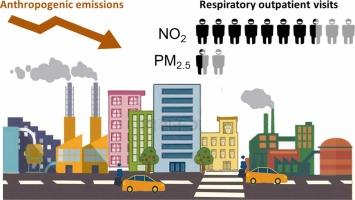Health risk assessment of NO2 exposure on respiratory outpatient visits in the North China Plain during wintertime
IF 11.3
1区 环境科学与生态学
Q1 ENGINEERING, ENVIRONMENTAL
引用次数: 0
Abstract
Nitrogen dioxide (NO2) exposure has rarely been explored with respiratory outpatient visits in China. The Generalized Additive Model (GAM) is first employed to assess health related risk (RR) with NO2 and PM2.5 exposure in Tianjin during the winter of 2019/2020. The RR of NO2 exposure is 1.018 (95% CI: 1.012-1.024) on lag 3 days, while that of fine particulate matter (PM2.5) exposure is 1.005 (95% CI: 1.002-1.008) on lag 4 days per 10 μg m-3. The Weather Research and Forecasting model coupled to Chemistry (WRF-Chem) model is used to simulate the pollutant concentrations to calculate the total number of excess visits (EN) in the North China Plain (NCP) in the 2019/2020 winter. The EN of NO2 exposure is 0.97 million (95% CI: 0.67, 1.27), while for PM2.5 exposure is 1.19 million (95% CI: 0.50, 1.84). With the anthropogenic emission mitigation, the PM2.5 concentration has dropped by 40.3 μg m-3 on average in the NCP, but the NO2 concentration has rebounded by 1.8 μg m-3. The emissions mitigation reduces NO2-related EN by 0.76 million (95% CI: 0.53–0.98) and PM2.5-related EN by 1.11 million (95% CI: 0.48–1.69). The findings underscore that reducing NO2 emissions could yield more substantial health benefits.

华北平原冬季呼吸道门诊NO2暴露的健康风险评价
在中国,二氧化氮(NO2)暴露很少与呼吸道门诊就诊进行探讨。首次采用广义加性模型(GAM)对天津市2019/2020年冬季NO2和PM2.5暴露的健康相关风险(RR)进行评估。每10 μg m-3,二氧化氮暴露滞后期3 d的相对危险度为1.018 (95% CI: 1.012 ~ 1.024),细颗粒物(PM2.5)暴露滞后期4 d的相对危险度为1.005 (95% CI: 1.002 ~ 1.008)。利用WRF-Chem模型对2019/2020年冬季华北平原大气污染物浓度进行模拟,计算了华北平原大气污染物的超量访问(EN)总量。NO2暴露的EN为97万(95% CI: 0.67, 1.27), PM2.5暴露的EN为119万(95% CI: 0.50, 1.84)。随着人为排放的减缓,PM2.5浓度平均下降了40.3 μg m-3, NO2浓度反弹了1.8 μg m-3。减排使二氧化氮相关的环境污染指数减少76万(95% CI: 0.53-0.98), pm2.5相关的环境污染指数减少111万(95% CI: 0.48-1.69)。研究结果强调,减少二氧化氮的排放可以产生更大的健康益处。
本文章由计算机程序翻译,如有差异,请以英文原文为准。
求助全文
约1分钟内获得全文
求助全文
来源期刊

Journal of Hazardous Materials
工程技术-工程:环境
CiteScore
25.40
自引率
5.90%
发文量
3059
审稿时长
58 days
期刊介绍:
The Journal of Hazardous Materials serves as a global platform for promoting cutting-edge research in the field of Environmental Science and Engineering. Our publication features a wide range of articles, including full-length research papers, review articles, and perspectives, with the aim of enhancing our understanding of the dangers and risks associated with various materials concerning public health and the environment. It is important to note that the term "environmental contaminants" refers specifically to substances that pose hazardous effects through contamination, while excluding those that do not have such impacts on the environment or human health. Moreover, we emphasize the distinction between wastes and hazardous materials in order to provide further clarity on the scope of the journal. We have a keen interest in exploring specific compounds and microbial agents that have adverse effects on the environment.
 求助内容:
求助内容: 应助结果提醒方式:
应助结果提醒方式:


